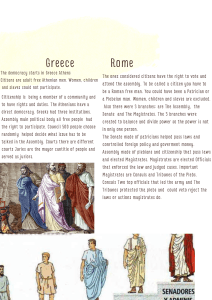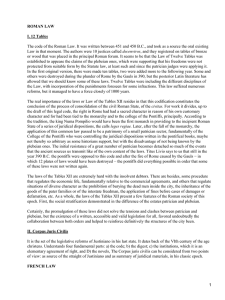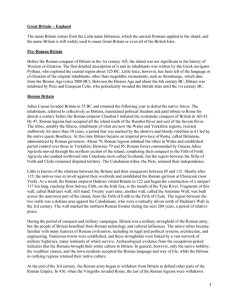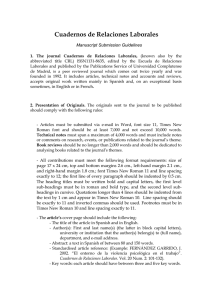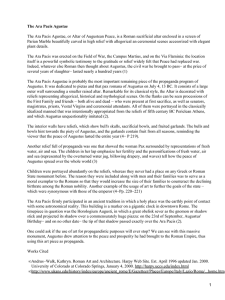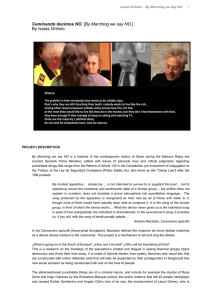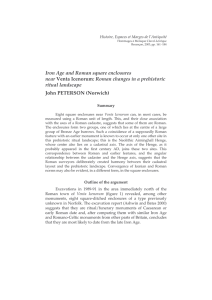The end of local magistrates in the Roman Empire
Anuncio
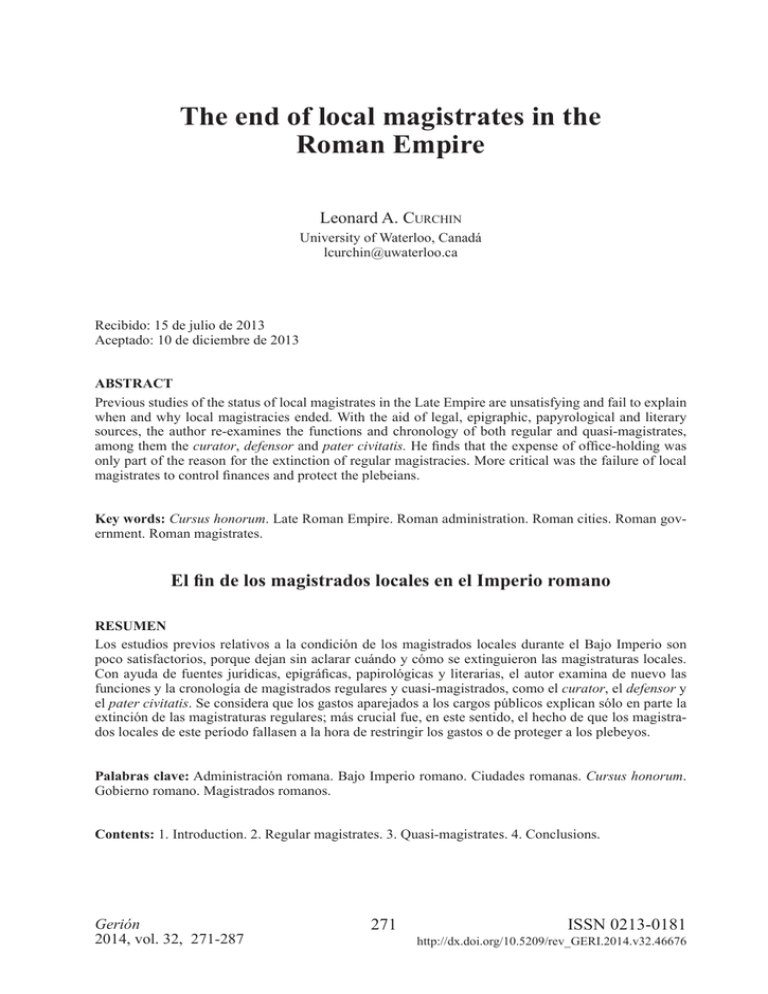
The end of local magistrates in the Roman Empire Leonard A. Curchin University of Waterloo, Canadá [email protected] Recibido: 15 de julio de 2013 Aceptado: 10 de diciembre de 2013 ABSTRACT Previous studies of the status of local magistrates in the Late Empire are unsatisfying and fail to explain when and why local magistracies ended. With the aid of legal, epigraphic, papyrological and literary sources, the author re-examines the functions and chronology of both regular and quasi-magistrates, among them the curator, defensor and pater civitatis. He finds that the expense of office-holding was only part of the reason for the extinction of regular magistracies. More critical was the failure of local magistrates to control finances and protect the plebeians. Key words: Cursus honorum. Late Roman Empire. Roman administration. Roman cities. Roman government. Roman magistrates. El fin de los magistrados locales en el Imperio romano RESUMEN Los estudios previos relativos a la condición de los magistrados locales durante el Bajo Imperio son poco satisfactorios, porque dejan sin aclarar cuándo y cómo se extinguieron las magistraturas locales. Con ayuda de fuentes jurídicas, epigráficas, papirológicas y literarias, el autor examina de nuevo las funciones y la cronología de magistrados regulares y cuasi-magistrados, como el curator, el defensor y el pater civitatis. Se considera que los gastos aparejados a los cargos públicos explican sólo en parte la extinción de las magistraturas regulares; más crucial fue, en este sentido, el hecho de que los magistrados locales de este período fallasen a la hora de restringir los gastos o de proteger a los plebeyos. Palabras clave: Administración romana. Bajo Imperio romano. Ciudades romanas. Cursus honorum. Gobierno romano. Magistrados romanos. Contents: 1. Introduction. 2. Regular magistrates. 3. Quasi-magistrates. 4. Conclusions. Gerión 2014, vol. 32, 271-287 271 ISSN 0213-0181 http://dx.doi.org/10.5209/rev_GERI.2014.v32.46676 Leonard A. Curchin The end of local magistrates in the Roman Empire 1. Introduction Eminent authorities assert that the standard municipal magistrates in the Late Empire were quaestor, aedile and duumvir, 1 but this is at best a gross simplification. Not all cities had duumviri, while quaestors and aediles are very rarely attested after the third century; they were replaced by new types of officials. Moreover, there was considerable variety in local magistracies, not only between the Western and Eastern empires with the contrast between Latin and Greek titulary, but sometimes differences from one province to another. Therefore a single model will not fit all cases. The question, when and why did local magistracies end, has never been satisfactorily addressed. 2 It is this deficiency that the present article seeks to address. Two preliminary cautions are in order. First, it is important to distinguish between true magistrates (annually elected local officials) and quasi-magistrates, for instance those appointed by the Roman state or holding office for protracted periods. 3 Late Roman magistrates were elected by the decurions (more commonly known in this period as “curials” or, in Greek, bouleutai or politeuomenoi) from among their own number rather than by popular election, 4 though in some places there were still popular elections as late as the age of Constantine. 5 The second point to appreciate is the uneven nature of the sources. The epigraphy consists largely of Christian epitaphs and dedications to the emperors; very few inscriptions record local careers after the Severan period. The literary sources are scattered and often anecdotal. The historians, some of them ecclesiastical chronographers with little interest in civic affairs, refer vaguely to nobles, rich men and leading citizens of provincial towns, without indicating whether these were magistrates. 6 Egyptian papyri provide valuable attestations of civic administration, but only for a few cities. Legal sources include local magistrates 1 Jones 1964, 720-730 and note 39; Thompson 1969, 121. Two of the sources cited by Jones (CJ 12,1,21; CIL III 6866 = ILS 6090) mention magistratus rather than duumviri, though the terms may be synonymous. My thanks to Ralph Mathisen and John Traill for information on the local magistrates of Gaul and Athens. 2 The best overall treatment of Late Roman local magistrates is Liebeschuetz 2001. On Africa and Italy see Lepelley 1979-81 and Ausbüttel 1988; and on the eastern provinces, Laniado 2002. 3 E.g. Liebeschuetz 2001, 110, refers to the curator, defensor and pater civitatis as “semi-official, semicivic officials” because they were locally chosen but their appointment came from the imperial government. 4 The curia must meet on March 1, with two-thirds of the curials present, to vote on magistrates and munera for the following year: CTh. 12,1,28 (A.D. 339), 12,1,84 (381); cf. 12,1,8 (323). Since the early third century, selection of magistrates was subject to approval by the provincial governor: Dig. 49,4,1 Ulpian, on which see Carrié 1995, 299. On membership in the curia as a prerequisite for magistracy, see Ausbüttel 1988, 9. 5 In the regulations for Tymandus in Pisidia (CIL III 6866 = ILS 6090) Diocletian instructs the inhabitants to elect the magistrates as is done in other cities. In CTh. 12,5,1 (326), while tasking duumviri to nominate their own successors, Constantine acknowledges that in Africa the candidates are approved by popular vote. However, in a Diocletianic inscription from Thibilis (Numidia), the duumvir Marcellinus records that the ordo spontaneously conferred the honour upon him (“honorem du(u)mviratus ultro ab ordin(e) suo in [se] conlat[um]”: ILAlg. II,2, 4636). 6 For example in Syria and Mesopotamia: Amm. Marc. 18,10,1; 25,9,3; Procop., Hist. 1,7,32; 1,26,8; 2,21,27; Ioannes Malalas, Chronographia, ed. L.A. Dindorf (Bonn, 1831, 295); Theodoret, Ep. Sirm. 33 and 47; Ps.-Joshua, Chron. 43 and 86; Ps.-Zachariah 7,4. On the difficulty of identifying Syrian municipal magistrates from the ambiguous wording of Libanius, see Petit 1955, 72-76. 272 Gerión 2014, vol. 32, 271-287 Leonard A. Curchin The end of local magistrates in the Roman Empire in their regulations, but we may suspect a disconnect between the emperors’ wishful prescriptions and the realities on the ground. 2. Regular magistrates Duumviri, the traditional pair of chief magistrates, are still mentioned in the Theodosian Code, in African inscriptions of the fifth century, and in an edict of the Ostrogothic king Theoderic in 512. 7 In their role as duumviri iure dicundo, they could judge civil cases involving such matters as property ownership and manumission, while in criminal cases they acted as investigating magistrates, conducting a preliminary hearing before sending the accused to the provincial governor. 8 Service as duumvir brought exemption from minor munera; however, a nominee for the duumvirate who fled and was returned was forced to serve two years in the office. Until the legalization of Christianity, a duumvir was not allowed to enter the Church. African inscriptions show serving duumviri and former ones (duumviralicii) in the fourth century sponsoring spectacles and restoring public buildings. 9 Although any magistrate could be called magistratus, 10 this term is sometimes used in late sources to mean duumvir. Thus, for instance, the regulations for Tymandus (Pisidia) call for the election of magistratus, aediles, and quaestors, while legal sources authorize the magistratus to draw up decrees and summon the decurions to meetings. 11 Less certain are the magistratus and magistratus quinquennales in the Ravenna papyri between A.D. 474 and 625. These are traditionally assumed to be duumviri, though Ausbüttel argues that, since papyri normally use exact terminology and the Ravenna documents never say duumvir, it is more likely that the magistratus is a successor to the magister municipii attested here in the Early Empire. 12 However, it is perhaps more likely that the term magistratus had replaced duumviri as the official designation of the chief magistrates of Ravenna. In the eastern provinces the chief magistrates were often known as archontes or stratēgoi. Unlike the duumviri they were not necessarily two in number. At Athens, where there had traditionally been nine archons per year, the epōnymos archōn 7 CTh. 12,1,174 (412), 177 (413); Lepelley 1979-81, 152-157; FIRA II, p. 692 §52-53. For a fourthcentury duumvir at Gaza (Palestine) see Hieron., Vita Hilar. 20. 8 CJ. 1,4 (320), 6,9,9 (339); CSEL 26, pp. 198-200. Their role was likely reduced in the fifth to sixth centuries. 9 Returned fugitive: CTh. 12,5,2 (337), 12,1,6 = CJ 10,32(31),18 (329). Barred from Church: Conc. Elvira (ca. 300-306), ch. LVI (p. 11 Vives). Munificence: Lepelley 1979-81, 308ff., no 41, 43, 50, 76-79. 10 E.g. CTh. 12,1,29 (A.D. 349) speaks of those qui magistratus gerunt; 15,5,1 (372) refers to the producing of spectacles by magistratus. The city of Orcistus (Phrygia) in the period 324-331 was adorned with the annual fasces of the magistrates (“annuis magistratum fascibus ornaretur”: CIL III 7000 = ILS 6041). In all these cases, magistratus presumably includes quaestors, aediles and duumvirs (or the eastern equivalents). 11 CIL III 6866 = ILS 6090; CJ 1,56,2 (A.D. 366), 10,32(31),2 (286-305). 12 Ausbüttel 1987, 210, invoking ILS 6665. Jones 1964, 761 assumes the magistratus are duoviri. Cf. mentions of magistratus at Syracuse in 489, and of mag(istratus) quinquennalis at Faventia in 540: Tjäder 1955-82, no 10-11 (=FIRA III, no 99) and 31. Gerión 2014, vol. 32, 271-287 273 Leonard A. Curchin The end of local magistrates in the Roman Empire emerged as the chief magistrate. 13 Similarly at the helm of other eastern cities we find a “first archon” (prōtos archōn), who was presumably also the eponymous archon. 14 That he was not the only archon of the year is indicated by the phrase prōton archonta archontōn 15 and by collective mentions of archontes, synarchontes and synarchia. 16 In a few places, such as Thessalonike in Macedonia and Panticapaeum in the Tauric Chersonese, the chief magistrate is styled poleitarchēs “ruler of the city”. 17 In numerous cities of Asia Minor, archons were responsible for local coinage in the third century, as their autonomous issues attest. Whether because of social prestige or shortage of candidates, some archons held office two or even three times. 18 The stratēgos held a magistracy equivalent to the duumvirate, as shown both by the synonyms “stratēgos magistratus duumvir” 19 and by two constitutions of A.D. 531, one in Greek listing the stratēgos, the other in Latin listing the duumvir, as equivalent to the defensor civitatis. 20 Also, where Justinian’s Institutes provide that legal guardians (tutores) are appointed by provincial governors or magistrates (praesides…vel magistratus), the Greek version reads “provincial governors and stratēgoi”. 21 That stratēgoi were also equivalent to archons is suggested both by a Severan inscription mentioning “[stra]tēgountōn tōn… [ar]chontōn” and by the coin issues of Aurelius Papias of Blaundos in Phrygia (A.D. 251-253), who variously calls himself stratēgos and first archon. 22 In Egypt, the title stratēgos is used for the governor of a nome. In earlier times the number of stratēgoi varied from city to city, being sometimes five, six or nine; once they had been equated with duumviri, this number was reduced to two. Thus, for instance, at Heliopolis (Phoenicia) in A.D. 430/1 we find a pair of stratēgoi, Serenus and Athenaeus. At Aizani in Phrygia we find a “first stratēgos”. 23 Every five years the duumviri or archons took the title quinquennales. 24 Holders of the quinquennalitas often had held the duumvirate more than once, and some were 13 The title epōnymos archōn also appears in inscriptions from the island of Syros (IG XII, 5 666, A.D. 23841; 667 = Syll.3 890, A.D. 251), and the phrase arxantos tēn epōnymon archēn “having held the eponymous archonship” at Oropos in Boeotia (Oliver 1941, 541-542, ca. A.D. 230). At Delphi in 319 an inscription is dated in the archonship (epi archontos) of Babbius Aurelius Philistion (Syll.3 901 = SEG 12, 226). The last recorded archon of Athens is Nicagoras the younger in 484/5 (Marinus, Vita Procli 36). For a list of late Athenian archons see Oliver 1942, 89. 14 So Dmitriev 2005, 232. This official is called prōtarchōn at Philippopolis: IGBulg. III,1 1515 (235238); V 5409 (267/8). At Aphrodisias in Caria we find a prōtologos archōn who was first to speak in council: CIG II 2760-65, MAMA VIII 512 (all 233-300). 15 Barth – Stauber 1996, no 2683 (Olympene, 238-244), SEG 41, 1174 (Alia, ca. 249); IGRR IV 700 = MAMA 4, 59 (Synnada, 293-305). 16 IGLS 13, 9084 (undated), 9104 (late second century); Welles 1938, no 74 (Gerasa, A.D. 259). Cf. a triad of archons at Traianopolis in Phrygia: IGRR IV 626 (251/2). 17 IG X,2,1 162 (246/7), 163 (ca. 249/50), 199 (mid-third century), 214 (240/1); IGRR I-II 871. 18 Three times: IGRR IV 700 = MAMA 4, 59 (293-305). 19 Corpus gloss. ed. Götz-Gundermann 2, 438, 44. 20 CJ 1, 4, 30 pr.; 3, 1, 18. 21 Inst. 1, 20, 4; Paraphrasis Theophili 1, 20, 4. 22 CIG 3871 = IGRR IV, 686 (Sebaste, Phrygia); Head 1901, 57, no 91-93. 23 Heliopolis: ILGS VI, 2831 + Bull. epig. 1994, 645. Cf. plural stratēgoi at Kollyda (Lydia) in 274/5: Herrmann 1981, no 386. Aizani (stratēgos prōtos): MAMA 9, 17, 244-260. 24 Cf. an archōn pentaeteriōn at Patras in Achaea in the first half of the fourth century: Rizakis 1998, 120124, no 37. 274 Gerión 2014, vol. 32, 271-287 Leonard A. Curchin The end of local magistrates in the Roman Empire also curatores rei publicae. 25 Their traditional role was to conduct the local census, including the assessment of property for taxation purposes. 26 According to Langhammer, “when Diocletian transferred the business of the quinquennales to state officials, the quinquennalitas practically lost all its earlier meaning and signified only as an honorary position”. 27 This is an oversimplification. There is no evidence that Diocletian’s tax reform legislation of the 290s removed from local magistrates the responsibility for tax assessment. However, it soon became apparent that local politicians could not be trusted to assign tax liabilities and exemptions impartially. For instance, the entire city council of Panopolis in Egypt was imprisoned in A.D. 300 by the procurator of the Lower Thebaid for falsifying tax returns. 28 Thus in 306 the emperors Galerius and Constantius ordered an empire-wide census, in which tax assessors (censitores) visited each town, enumerating every person, slave and animal and exhaustively recording every field, tree and vine. 29 From this point the quinquennales ceased to bear responsibility for the census. But if the quinquennalitas was an empty honour, it would not have continued to be recognized in the law codes and distinguished from the ordinary duumvirate. Undoubtedly the quinquennales still had certain duties every five years, such as revising the album of curiales. Constitutions of Constantine give equal judicial responsibility to ordinary duumviri and quinquennales. 30 Lepelley assumes from the absence of quinquennales in the album of Timgad (A.D. 361-363) that by the fourth century they no longer existed in some cities, 31 but this album probably did not coincide with a quinquennial year. The last known individuals to serve as quinquennales date to the end of the fourth century. 32 In the later empire the quinquennales, like other magistrates, had the limited role of certifying gesta municipalia. We find them mentioned in this capacity in the aforementioned edict of Theoderic. Specific mentions of municipal aediles (in Greek, astynomoi) are scarce after the third century. 33 They are prescribed in the regulations for Tymandus (Pisidia) under Diocletian. 34 An undated constitution of Constantine orders provincial governors to punish any slave who assumes the office of an aedile. 35 In 315 the former duovir Alfius Caecilianus of Aptunga (Africa) testified that he had been aedile with a certain Augentius, and in 322 we have mention of an aedile and aedile-designate at Zama Regia. An aedile 25 Haeck 2005, 604 and 614. censoriae potestatis quinquennales: ILS 6126, 6147, cf. 6918, 6085.142-156. 27 Langhammer 1973, 255. 28 Williams 1985, 122-123. 29 Lactantius, De mort. pers. 23. Panegyrici Latini 8,5 and 13 of 311/12 refers to the novi census… acerbitas five years previously. Ioannes Lydus, De magist. 1,4 wrongly attributes the new census to Diocletian. See Goffart 1974, 44-49 and 62. 30 CTh. 4,6,3 (A.D. 336), 13,3,1 (321/324). 31 CIL VIII 17824 = ILS 6122; Lepelley 1979-81, 142, 158. However, ex-quinquennales do appear in the album of Canusium, A.D. 223. 32 CIL IX 259 = ILS 6115 (Genusia, Italy, A.D. 394). 33 On the duties of astynomoi as spelled out in a Pergamese law dating to the Principate (responsibility for streets, bridges, sewers, water supply, garbage) see Jones 1940, 213-14. Unlike their counterparts in the Latin West, astynomoi were not in charge of markets, a function of the agoranomoi (discussed below). 34 aediles…creare debebunt: CIL III 6866 = ILS 6090. 35 qui aedilitate fungitur: CJ 10,33(32),2. 26 IIviri Gerión 2014, vol. 32, 271-287 275 Leonard A. Curchin The end of local magistrates in the Roman Empire is attested at Hispellum (Italy) in the early-to-mid fourth century, while an inscription of 352 from Colonia Agrippinensis (Germania Inferior) commemorates an ex-aedile (aedilicius) who was subsequently duumvir and curator. Two aediles are mentioned in the Timgad album, and under Valentinian I (364-375) we find record of an aedile of Tripoli named Nicasius. 36 An unusually late aedilicius is attested at Thuburbo Maius between 395 and 408. 37 However, there are two less explicit designations of aediles. One is the use of the term quattuorviri, which is generally assumed to comprise two duumviri and two aediles. For instance, an imperial letter from Heraclea Sintica (Macedonia) in 307/8 is addressed to the quattuorviri and decuriones. 38 The other indicator is the phrase omnibus honoribus functus which implies the duties of quaestor, aedile and duumvir. 39 The Theodosian Code stipulates that no one can become a provincial governor unless he has completed each step of the municipal cursus: “He shall not begin at the office of duumvir…but shall observe the regular order and sustain the responsibility of all the offices.” 40 At Stratonicea (Caria) a Christian inscription, perhaps of the fifth century, honours one Maximus, who performed all offices (pantarchēsanta) and many great services. 41 Quaestores (Greek tamiai), officials not found in all cities even under the Early Empire, 42 are prescribed in the Tymandus regulations already cited, and, like aediles, may be presupposed in the collective title omnibus honoribus functus. Only one quaestor, rather than a pair, appears in the Timgad album, possibly owing to a temporary vacancy. 43 Quaestors are not mentioned at all in late juridical sources. Although quaestors are attested at a few Italian cities in the fourth century, it is likely that in many places the financial functions of the quaestor in this century were absorbed by the curator civitatis. 44 3. Quasi-magistrates Within the local curia the principales held a position of prominence and power which has sometimes been referred to as a quasi-magistracy. 45 Although principales viri are 36 Acta purgationis Felicis = CSEL 26, p. 199,20 and 203,27; CIL VI 1686; ILS 6122, 6623, 7069; Amm. Marc. 28,6,10. See also CIL VI 1684 for aediles at Chul (Byzacena) in 321. 37 ILAfr. 276. 38 AE 2002, 1293 = AE 2004, 1331. 39 E.g. AE 1940, 48 (Suessa Aurunca, fourth century); CIL X 4559 (Trebula, mid-to-late fourth century), 5349 (Interamna, A.D. 408). Cf. maioribus honoribus functos: CJ 10,43,2 (A.D 285-293). 40 “nec vero a duumviratu…incipiat, sed servato ordine omnium officiorum sollicitudinem sustineat”: CTh. 12,1,77 (A.D. 372). 41 Varinlioğlu 1988, 123-124. 42 Curchin 1990, 29-30. 43 Lepelley 1992, 64, note 1, and 164 note 183 on other African quaestors. 44 CIL X 4559; XI 5283 = ILS 6623; Petit 1955, 75. 45 “une quasi-magistrature”: Kotula 1982, 37. Ausbüttel 1988, 19 similarly says the principalitas came to assume “den Charakter einer Magistratur”. Cecconi 2006, 41 misleadingly calls it a “sorta di giunta”, a modern term more appropriate to military dictatorships. 276 Gerión 2014, vol. 32, 271-287 Leonard A. Curchin The end of local magistrates in the Roman Empire already mentioned in the Early Empire, 46 it is only after the mid-fourth century that they acquire a special, legally recognized status, becoming a kind of oligarchic inner circle or “executive committee” of the council. 47 Principales were elected by the curia from those who had discharged all honores and munera, i.e. they would have been duumvirales, and had to serve their community fifteen years before retiring. 48 It was frequently from their ranks that the curator and defensor were chosen. 49 The principales are known in some cities as primates, primores, prōtoi, prōtopolitai or, in Egypt, propoliteuomenoi. 50 That they numbered ten in some cities is implied by the terms decemprimi and dekaprōtoi. 51 However, the number could vary: at Alexandria there were only five primates, while in fourth-century Syria, Libanius suggests that twelve men were in charge at Antioch, and only six in some other towns. 52 Principales are distinguished from simple decurions in the legislation. 53 In some cities, special privilege was accorded to the most senior of the principales, variously known as the primus principalis, principalis ac primor, or primus curiae; he perhaps acted as president of the council. 54 In Italy at least, the principales seem to have borne the equestrian rank of viri laudabiles; a law of Theodosius gave them the rank of comites. 55 Though principales were generally exempt from corporal punishment, they were liable to scourging for fraud or to capital punishment for selling fugitive decurions. A law against Donatism prescribes for principales a fine of twenty pounds of gold, four times the amount for ordinary decurions. 56 The duties of the principales included the assessment and collection of taxes, the inspection of municipal accounts, and the enrolment of new members in the curia. 57 CIL II 6278 = ILS 5163 (A.D. 176-178). Petit 1955, 85 (“une sorte de comité executive”), a phrase echoed by Jones 1964, 731 and Liebeschuetz 1972, 172. 48 Chosen by curia (“consensu curiae eligendos”): CTh. 12,1,171,1 (A.D. 412); August., Ep. 50 (CSEL 34,2, p. 143). Munera: CTh. 12,1,77 (A.D. 372) and 127 (392). 49 Ausbüttel 1988, 229. 50 Another frequently encountered term, prōteuontes, often refers not to the leading members of the council but to the richest citizens: Liebeschuetz 2001, 113; Laniado 2002, 206-207; Di Paulo 2006, 169. On the propoliteuomenos as principalis rather than president of the boulē, see Bowman 1971, 125 and 158. 51 Jones 1964, 731 and Horstkotte 2000, 276, distinguish beween the decemprimi, referred to in legal sources of the third to early fifth centuries and in the land grant of Odoacer in 489 (FIRA III, no 99), and the dekaprōtoi, last mentioned in Egypt in 302 and in Sicily under Constantine (Thomas 1974; IG XIV 1078a = ILS 8843), although the difference is unclear. The identity of decemprimi and dekaprōtoi is accepted by Langhammer 1973, 254 and MacMullen 1976, 176. 52 CTh. 12,1,190 (A.D. 436); Libanius, Or. 2,33; 49,8; cf. Petit 1955, 323. 53 principales vel decuriones: CTh. 7,13,7,2 (A.D. 375), 12,1,85 (381); 12,1,117 = CJ 10,32(31),40 (387); CTh. 12,1,128 = CJ 10,32(31), 42 (392). 54 CIL XI 5283 = ILS 6623 (Hispellum, mid-fourth century); CIL X 7542 = ILS 5790 (Nora, Sardinia, A.D. 425-450); CTh. 12,1,189 = CJ 10,32(31),56 (Alexandria, 436). Pomponius Maximus, primor of Burdigala in the mid-fourth century, seems to have presided over the local curia (Auson., Parent. 15,7). 55 Ausbüttel 1987, 209; CTh. 12,1,127 (A.D. 392). 56 Exemptions: CTh. 9,35,6 = CJ 9,41,17 (A.D. 399); CTh. 12,1,75 (A.D. 371), 12,1,126 (392), 12,1,128 = CJ 10,32(31),42 (392). Punishments: CTh. 16,2,39 (408); CJ 10,32(31),40 (387); Nov. Major. 7,1,8 (458). CTh. 12,19,3 (400) threatens primates with unspecified punishment if they allow a fugitive from the municipal council to go abroad. Donatism: CTh. 16,5,52 (412). 57 Taxes: CTh. 8,15,5 (365), 10,25,1 (406); 12,1,117 (387) and 173 (410). Inspection of accounts: CJ 1,4,26 pr. and 3 (529, using proechontes and prōteuontes as equivalents of primores); Nov. Just. 128,16 (545). Enrolment: CTh. 12,1,79 (375). 46 47 Gerión 2014, vol. 32, 271-287 277 Leonard A. Curchin The end of local magistrates in the Roman Empire The principales helped to suppress Christian heresies; dispatched army deserters to the provincial governor for punishment; and, like the curator or defensor, could issue warrants for use of the cursus publicus when necessary. 58 They also represented their communities at the provincial concilium. 59 Principales are still mentioned in the Visigothic Formulae of the early seventh century. 60 In the Greek East we find a number of civic officials who have no exact equivalent in the West. Most of these do not meet the criteria of annually elected appointments, but were rather liturgies. The presidency of the town council (curia, boulē), which in the West was one of the duties of the duumviri, was held in the East by an official often called the prytanis; though technically signifying the presiding committee, the term was frequently used as the title of an individual. In Egypt in the third and early fourth centuries, the prytanis, prytanikos or archiprytanis was elected for one-tenth of the year (at least in those towns with ten tribes), and it is clear from P.Oxy. 1414 that there was only one prytanis at a time. In some fourth-century Egyptian metropoleis he was instead called proedros (chairman), though prytaneis are still attested in cities such as Oxyrhychus and Herakleopolis in the late fourth century. 61 In Asia the president was usually styled boularchos, proboulos or archiproboulos, a position which could be held for life and was considered a liturgy. 62 The secretary of the council was normally called the grammateus tēs boulēs, but in Egypt we sometimes find the alternative title skreibas, clearly a transliteration of the Latin term, from the late third century on. 63 The eirēnarchai, or wardens of the peace, though characterized as a “magistracy” by Jones, 64 were in reality appointed by the provincial governor on the nomination of the curials. Created in the second century, this office is still mentioned in a constitution of 409. 65 Other officials, sitōnai, were appointed by the city to purchase grain for the annona; they are still mentioned in the laws of Justinian. 66 In Egypt, the sitologoi were officers responsible, as a local liturgy, for collecting and storing grain for the state. 67 Some officials were concerned with units smaller or larger than a city. Villages (vici, castella, kōmai) had a less regulated organizational structure and therefore a greater variety of magistral titles. In villages in Africa we find magistratus, seniores and curatores; in Syria, archontes, phylakes, stratēgoi and dekaprōtoi; in Arabia, 58 Heresies: CTh. 16,5,40,8 (407), 16,6,4,4 (405). Deserters: CTh. 7,18,12 (403), 12,6,2 (440). Cursus: CTh. 8,5,59 (400). 59 CTh. 12,12,12 (392); Symm., Ep. 9,10,2. 60 Zeumer 1886, 587, no 25; cf. Isid., Etym. 9,4,25. 61 P.Oxy. 2110; Kiessling 1958-63, no 9597. In P.Lond. 233 (A.D. 345) the same individual is both prytanis and propoliteuomenos. 62 Dmitriev 2005, 220 and 231. 63 Bowman 1971, 39-40. 64 Jones 1940, 212-13. 65 CJ 10,77 (“irenarchae…a decurionibus iudicio praesidum provinciarum idonei nominentur”). 66 Claude 1969, 114; Erdkamp 2005, 269-279. 67 Aly 1950; Parassoglou 1978, passim. 278 Gerión 2014, vol. 32, 271-287 Leonard A. Curchin The end of local magistrates in the Roman Empire pronoētai, pistoi and dioikētai. 68 In such a small polity, the eirenarch was merely a “village policeman”. 69 The dēmarchos, executive officer of a deme, is still attested in the Greek colony of Neapolis (Naples) in the fourth century. In Egypt in the fourth to seventh centuries, districts were placed under the control of a praepositus pagi or pagarchos, typically one of the top municipal notables. He is to be distinguished from the topotērētēs, a local administrator appointed not by the city but by the dux Thebaidis. 70 Another official whose liturgical post has sometimes been regarded as a magistracy was the gymnasiarchos. 71 Since the gymnasiarch supervised the training of young men (ephēboi), his position in some cities was akin to a director of education. In other places the gymnasiarchy seems to have been an honorary office which could be held by women, such as Aurelia Leite of Paros who paid for the restoration of her cityʼs dilapidated gymnasium but presumably did not supervise the exercise of the naked youths. 72 Possibly she was in charge of female education. In Egypt the situation was more peculiar, in that the gymnasiarch was chosen exclusively from the gymnasial class, a restricted clique of persons of Greek ancestry who could prove descent from a list of charter members drawn up in A.D. 4/5. 73 The gerousiarchēs was head of the gerousia or association of elders. Although it had a religious function at Thessalonica (where a gerousiarch is attested in the third century), the gerousia in Asia and Egypt was essentially a social organization which, though often wealthy, had no political power. The other officers of the gerousia could include a secretary (grammateus), treasurer (tamias), auditor (logistēs) and patron (prostatēs). 74 The agoranomos was the liturgical official in charge of markets, prices, weights and measures, functions which in the West were part of the duties of the aedile. Agoranomoi are attested near Tralles (Caria) in the mid-third century, and at Oxyrhynchus in the 260s and 280s. At Antioch in the late fourth century, the agoranomos Pherenikos was sacked by the provincial governor during a food shortage. 75 A further quasi-magistrate was the exactor, or official in charge of tax collection, first attested in an Egyptian papyrus of 309. 76 He was chosen by the town council from among its own members, normally for one year, though a law of Honorius describes the intervention of the populace of Carthage in choosing exactores. 77 A pair of exactores, 68 Carrié 1995, 292; Liebeschuetz 1972, 119; Sartre 1993, 123-125; Jones 1931, 271. For pistoi in Arabia Petraea in the late fourth to early fifth centuries, see SEG 7, 1168 and 1229. 69 Bell – Martin – Turner – van Berchem 1962, 105. 70 Dēmarchos: CIL X 1492 = ILS 6459, cf. CIL X 1478 = ILS 6454. Pagus officials: Liebeschuetz 1974; Laniado 2002, 94. Topotērētēs: Kunderewitz 1962. 71 “municipal magistracies like the gymnasiarchy”: Bowman 1971, 58. 72 CIL XII,5 292 (ca. A.D. 300). Cf. Dmitriev 2005, 179 on female gymnasiarchs in Asia. 73 Bowman 1971, 28; Id. 2000, 182. 74 Dmitriev 2005, 134; Oliver 1941a, 36; Tacoma 2006, 116-117. 75 Tralles: Poljakov 1989, no 69, lines 20-21. Oxyrhynchus: P.Oxy. 1703, 2569. The office was revived here in 288 after a hiatus (P.Oxy. 1252); see Raschke 1974. Antioch: Libanius, Or. 27,18. 76 Thomas 1985. 77 CTh. 12,6,20 and 22 (A.D. 386), 11,7,29 (A.D. 412). Gerión 2014, vol. 32, 271-287 279 Leonard A. Curchin The end of local magistrates in the Roman Empire designated by the abbreviation EXCT, are listed among the flamines perpetuales in the album of Timgad. In the sixth century we find them only in Egypt. 78 The position of ambassador (legatus, presbys) was an obligation (munus, leitourgia) rather than a real magistracy. Though often assigned to a curial, or even a serving magistrate, 79 the office could be given to any citizen; for instance, a sixth-century inscription from Pergamon recognizes an embassy (presbeia politikē) undertaken by the sophist Heraclammon. 80 One of the duties of municipal ambassadors was to congratulate a new emperor on his accession or on a military victory, but they could also deliver petitions (for instance, requesting financial aid, complaining about imperial officials, or inviting the emperor to their city). 81 Some other liturgies were concerned with religious festivals, e.g. the panēgyriarchos attested at Apameia (Phrygia) under Valerian; or with public spectacles, such as the Syriarch and Alytarch (responsible for the Syrian and Olympic games, respectively) at Antioch, the tribunus voluptatum at Carthage, and the Bacauda (supervisor of public entertainments) at Mediolanum. 82 Since the time of Trajan, the curator rei publicae or curator civitatis (in Greek, logistēs) had been appointed from the ranks of senators and equites, on a temporary basis, to supervise the finances of cities in economic difficulty. 83 In the course of the third century, however, the curator rei publicae became a regular office recruited from among local notables (which could include senators), though the candidates, nominated by the town council, still received their appointment from the emperor. 84 In the fourth century the curator became a municipal administrator elected by the curials every year at the same time as the magistrates, in effect serving as the “mayor” or chief municipal officer of the city. 85 The office was rarely held by senators after the fourth century. 86 78 Timgad: Lepelley 1979-81, 211, cf. 215. Egypt: Laniado 2002, 113. the duoviri and aediles of the municipium Chullitanum (Byzacena) who undertook an embassy of hospitium in 321: CIL VI 1684. 80 Anth. Gr. XVI, 36 (vol. IV, p. 324). For a list of African legati see Lepelley 1979-81, 211 note 76. On legati generally, see Rodríguez Neila 2010. 81 See Liebeschuetz 1972, 266-269 for a catalogue of embassies sent by Antioch in the second half of the fourth century. 82 Panegyriarch: Ramsey 1897, 276. Syriarch, Alytarch: Ioannes Malalas, Chronographia, ed. L.A. Dindorf (Bonn, 1831, 286); Petit 1955, 72; Liebeschuetz 1972, 140-141. Carthage: CTh. 15,7,13 (A.D. 414415). Bacauda: Cass., Var. 5,25 and 7,10. The offices of Alytarch and Syriarch were transferred from decurions to provincial dignitaries in A.D. 465: Liebeschuetz 2001, 206. 83 Curator rei publicae is the usual title in the Early Empire, curator civitatis in the Late Empire. Nonetheless, the curator rei publicae is still found in local inscriptions in the late fourth century. Italian examples include CIL V 1862 = ILS 5885 (Iulium Carnicum, A.D. 373), CIL XI 5996 = ILS 5519 (Sestinum, 375), CIL XI 2834 (Volsinii, 376), CIL XI 6328 = ILS 5903 (Pisaurum, 378), AE 1925, 91 (Surrentum, end of fourth or beginning of fifth century). 84 On appointment of curators by the emperor in the late third century (curator datus ex indulgentia principis) see Camodeca 1980, 480. In the Ostrogothic period the curator civitatis was appointed by the king: Ausbüttel 1988, 215. 85 Chastagnol 1982, 292; Rees 1953-54, 87. 86 The last known senatorial curators in Italy date to the early fourth century: Ausbüttel 1988, 30. On senatorial curators in Africa in the fourth century (and one at Carthage as late as 411) see Lepelley 1979-81, 187-189. 79 E.g. 280 Gerión 2014, vol. 32, 271-287 Leonard A. Curchin The end of local magistrates in the Roman Empire A constitution of 331, which shows that the appointment was made by an imperial epistula, forbade curials from becoming curators unless they had held all munera in their city. 87 This regulation, which prevented curials from escaping their civic duties, had the effect of limiting candidacy to the principales, those curials who had discharged all municipal offices. The curatorship thus became the pinnacle of a municipal career, held after the duumvirate and flaminate, as is clear from the numerous inscriptions of curators who had exercised these posts. 88 The importance of this position relegated the duumviri to second place; in the album of Timgad, for instance, they are listed after the curator. The appointment of a curator was normally for one year, with a possibility of renewal. 89 Election by the curials of the curator, as holder of the principalis locus in the city, is still provided for in a law of Honorius in 412. 90 The same man could be curator at more than one town: for instance, at the beginning of the fourth century, L. Mamilianus Crispinus was curator of both his own city Suessa Aurunca in Latium and the neighbouring town of Sinuessa. 91 The curator could also hold other posts: the curators of Ostia in the early fourth century were simultaneously praefecti annonae, and the curators of Misenum, Ravenna and Comum were sometimes also praefecti classis. 92 The curator subsumed the powers of the traditional magistrates. His responsibilities included supervising not only civic finances (rationes publicae) but also markets and public works. 93 Thus in addition to replacing the duumviri as chief office-holder, the curator usurped the functions of the quaestors and aediles, rendering those magistracies redundant and contributing to their disappearance in many cities. It is likely that he also supplanted the curator Kalendarii, an official mentioned in inscriptions and in a law of 314, who managed the municipal debt records. In Africa at least, curators sometimes repaired public buildings at their own expense. 94 The defensor civitatis has also been considered a local magistrate by some authors. 95 Although in legal sources the equivalent Greek term was syndikos, evidence from Egypt shows that throughout the fourth century this official was known variously as syndikos or ekdikos, 96 terms which in the Early Empire had designated the public advocate who represented the city in a trial. 97 The evidence of the jurists Hermoginianus and Arcadius Charisius, both writing under Diocletian, tallies with the 87 CTh. 12,1,20; cf. Frakes 2001, 71. 1979-81, 186-187. In the fourth century the curator was still “the crowning stage” of the local cursus: Carrié 1995, 296. In the fifth and sixth centuries, however, the curator was second in importance to the defensor: Liebeschuetz 2001, 126. 89 Rees 1953-54, 95-96. 90 CTh. 12,1,171,1-2, cf. Horstkotte 2000, 276-278. 91 AE 1940, 48. 92 Ausbüttel 1988, 31-32. 93 Rees 1953-54, 98; Lepelley 1979-81, 191-192; Bowman 2000, 184; Liebeschuetz 2001, 193. 94 Curator Kalendarii: CTh. 12,11,1; Ausbüttel 1988, 33. African buildings: ILAlg. I, 2107-08 (A.D. 399/400 and 407/408). 95 “the principal magistrate of each city”: Jones 1940, 208; “a municipal magistrate”: Thompson 1969, 125. 96 Dig. 50,4,1,2 Hermogenianus (“defensio civitatis, id est ut syndicus fiat”), 50,4,18,13 Arcadius Charisius (“defensores quoque quos Graeci syndicos appellunt”); Frakes 2001, 56. 97 Plin., Ep. 10,110; Dig. 43,24,5 Labeo apud Ulpian. 88 Lepelley Gerión 2014, vol. 32, 271-287 281 Leonard A. Curchin The end of local magistrates in the Roman Empire testimony of contemporary papyri as seeing the defensor in this early period as a legal representative of the city, but not as a judge. 98 In addition, a constitution of 319 seems to give the defensor a sort of police duty: he is required to track down and return runaway slaves, and if he fails he must replace them. 99 A papyrus of Nov. 326 reveals a pair of syndikoi, who are also magistrates at Hermopolis, submitting to the praeses of the Thebaid their report on a complaint of robbery, asking him for a judgment on this criminal matter. 100 This is the last known occurrence of the defensorate as a collegial office. It thus appears that Constantine strengthened the position of the defensor civitatis into the equivalent of a juge dʼinstruction. Frakes may well be correct in postulating that this more powerful role was given to the defensores in lost Constantinian legislation as a check on the growing authority and corruption of the curatores. 101 This judicial role of the defensor is reflected not only in papyri from various Egyptian towns in the period 326-350, 102 but in sources of the early 360s. In 363 one Silvanus was trial judge (defensor causarum) in the eastern city of Nisibis, while in the same year Auxentius, a leading councillor of Tarsus, was appointed syndikos, obviously an important post since the appointment was made by the consular of Syria. An edict of Valentinian I in 365 lists the types of causae that a defensor should handle. 103 In 368, however, Valentinian created the office of defensor plebis, charged with protecting the plebeians against the abuse of curials, landowners and government administrators. 104 Originally an imperial appointee with the dignity of a senator, 105 the defensor soon became a locally chosen official: in 387 Theodosius ruled that he should be elected by each city, subject to confirmation by the Praetorian Prefect. 106 By the fifth century the defensor still had jurisdiction in minor cases but had to refer major crimes to a iudicium. 107 He was also responsible to enforce the law against Donatists, Montanists and Priscillianists. 108 In 420, St. Augustine complained that there was a lack of defensores to protect the commoners from being crushed by the powerful. 109 A further change, indicative of the growing power of the Church at the expense of the town council, occurred in 505 when Anastasius entrusted the selection of defensores to the bishop, clergy, decurions and landowners. 110 Justinian lamented that the defensores were generally despised as mere tools of the governor, who could 98 Frakes 2001, 33-37. 6,1,5, on which see Frakes 1994, 346-347. 100 P.Strasb. Inv. 1265 + P.Strasb. 296 recto. 101 Frakes 1994, 346-347. 102 Kramer 1990. 103 Silvanus: Amm. Marc. 25,9,4; cf. Frakes 1992. Auxentius: Libanius, Ep. 1392, discussed by Petit 1955, 81. Edict: CTh. 1,29,2 = CJ 1,55,1. 104 CTh. 1,29,1. Curials were explicitly barred from holding this office: CJ 1,55,2 (A.D. 365); CTh. 1,29,3 (373). 105 “dignitas…sen[a]toris”: CTh. 1,29,5 (A.D. 370) 106 CTh. 1,29,6. 107 CTh. 9,2,5 = CJ 1,55,7 (A.D. 409). 108 CTh. 16,6,4 (A.D. 405), 16,5,40,8 (407). 109 August., Ep. 22* (in CSEL 88). Cf. Nov. Major. 3 (A.D. 458) on the absence of defensores in many towns and provinces. 110 CJ 1,4,19. 99 CJ 282 Gerión 2014, vol. 32, 271-287 Leonard A. Curchin The end of local magistrates in the Roman Empire appoint and dismiss them at will. Henceforth the nobles of the city were to exercise the office of defensor in turn; the appointment was for two years, and the governor was not authorized to remove him. 111 The defensor thus became, in effect, a local magistrate. Legal sources of the fifth century refer to cities that non habent magistratus, i.e. their magistracies had been dismantled, but do have a defensor. 112 The pater civitatis (in Greek, patēr tēs poleōs), first attested from the mid-fifth century, was found in the eastern provinces and Sicily. The old assumption that he supplanted the curator (logistēs) is disproved by papyri in which the same individual is both logistēs and patēr. 113 While the post of pater civitatis was sometimes held by a clarissimus (lamprotatos), he could also be chosen from among the curials (politeuomenoi). 114 In those cities that had a pater, he appears to have been in charge of civic revenues and public construction. 115 In legal sources, he is given equal authority to the defensor (ekdikos) to deal with such matters as heretics, gambling, weapons manufacture and abandoned children. 116 In addition, the pater was in charge of the city’s building police, to prevent the streets and public squares from being encroached upon. 117 Claude’s contention that a city would possess either a defensor or a pater civitatis is refuted by the co-existence of both offices at Mopsuetus (Cilicia) and Ephesus. 118 A Late Antique scholiast on Demosthenes equates the aedile (astynomos) with the patēr tēs poleōs. 119 Certainly the pater exercised some of the traditional functions of the aedile (public buildings; competence in minor judicial matters) but his office was far more powerful and prestigious. The pater also had an eponymous role, as numerous inscriptions are dated to a specific pater, though it remains unclear how long an individual held this office or how he was appointed. The office continued beyond the Roman period, as patres civitatum are attested at Syracuse in the early eighth century and at Cherson in the ninth. 120 4. Conclusions The Late Antique world should be seen “not as a world in decline…but as a world in transition.” 121 Local office-holding changed rather than disappeared. The lesser magistracies (quaestor, aedile) are not explicitly attested after the fourth century, though mentions of omnibus honoribus functus, possibly including these offices, continue into the fifth. Duumviri as such are last mentioned in the early sixth century, though 111 Nov. Just. 15 pr. and 1-3 (A.D. 535). 8,12,8 (A.D. 415); CJ 8,53,30,1 (459). 113 Sijpesteijn 1987, contra Jones 1940, 209 and Rees 1953-54, 94. 114 Roueché 1979, 177-179; Laniado 2002, 94. 115 Liebeschuetz 1992, 5, calls the pater (at Aphrodisias in Caria, where several are attested) “a new civic finance officer”. For examples see Roueché 1989, passim. 116 CJ 1,5,12,7 (A.D. 487 or 510); 3,43,1,1 (529); 8,51,3,3 (529); Nov. Just. 85,3,1 (539). 117 CJ 10,30,4,14 (530). 118 Claude 1969, 135; Dagron – Feissel 1987, 220. 119 Demosthenes, vol. IX: Scholia graeca, ed. W. Dindorf (Oxford, 1851, 776, lines 16-17). 120 Laurent 1966, 46-47; Constantine Porphyrogenes, De administrando imperii 42. 121 Bowersock 1988, 170. 112 CTh. Gerión 2014, vol. 32, 271-287 283 Leonard A. Curchin The end of local magistrates in the Roman Empire magistratus (possibly another name for the same office) continue for a further century at Ravenna. However, two factors must be kept in mind when considering the date at which the traditional magistracies ceased to function. First, a decline in the “epigraphic habit” means that there are far fewer records of local careers than in the Early Empire. Therefore local magistrates in many cities may have continued later than the surviving evidence would suggest. Second, regional differences must be taken into account. Thus, for example, there are almost no late magistrates attested in provinces like Gaul or Syria, whereas they continue in Italy and Africa. Meanwhile, alternative offices had gained currency. In the fourth century, the defensor acquires a more powerful role, while the curator (originally a senatorial overseer) becomes a city administrator. They are joined, in the fifth century, by the pater. These offices were open to senior curials, i.e. principales, who collectively formed a sort of inner cabinet directing municipal government. The curator, defensor and pater, though usually chosen locally, received their official appointment from the central government, to which they were thenceforth responsible. Thus we have “the creation of a body of municipal officials who worked with the boule but were not answerable to it”. 122 Why did traditional magistracies cease to exist? The usual explanation, which applies to decurions as well as to magistrates, is that the increasing financial burdens in the Late Empire, including responsibility for tax collection and the cost of sponsoring ludi in an age of rampant inflation, made office-holding undesirable. As the imperial authority confiscated more of the city’s wealth and made ever greater demands on local officials, many of the urban elite fled to evade the expensive munera that constituted a powerful disincentive to office-holding. With the curia thus depleted, power and wealth became concentrated in a controlling oligarchy, the principales. However, this customary explanation tells only part of the story. Another, perhaps more critical, factor was the failure of municipal government to manage cities efficiently. The bankruptcy of many, especially eastern, cities as early as the second century, as a result of irresponsible overspending, led to the imposition of curatores to monitor local finances. In the fourth century, the failure of local magistrates to protect the commoners from abuses by the rich, prompted the creation of the office of defensor. The judicial and financial prerogatives of the duumviri, aediles and quaestors were eroded by these new appointments, making them largely redundant. Where they still existed, these magistrates were essentially confined to a notarial function, witnessing legal documents. As the magistrates and curials were systematically divested of their old powers, civic leadership became shared with other powerful men in the community, namely the bishop (episcopus), senatorial nobles (honorati) and large landowners (possessores). Thus the primacy of local magistrates passed into oblivion, superseded by other local elites. 122 Bowman 284 1971, 125. Gerión 2014, vol. 32, 271-287 Leonard A. Curchin The end of local magistrates in the Roman Empire REFERENCES Aly, Z. (1950): “Sitologia in Roman Egypt”, JJP 4, 289-307. Ausbüttel, F. M. (1987): “Die Curialen und Stadtmagistrate Ravennas im späten 5. Und 6. Jh.”, ZPE 67, 207-214. (1988): Die Verwaltung der Städte und Provinzen in spätantike Italien, Frankfurt. Barth, M. – Stauber, J. (1996): Inschriften Mysiae und Troas, München. Bell, H. I. – Martin, V. – Turner, E. G. – van Berchem, D. (1962): The Abinnaeus archive. Papers of a Roman officer in the reign of Constantius II, Oxford. Bowersock, G. W. (1988): “The dissolution of the Roman Empire”, [in] N. Yoffee – G. Cowgill (eds.), The Collapse of Ancient States and Civilizations, Tucson, 165-175. Bowman, A. K. (1971): The town councils of Roman Egypt (=ASP 11), Toronto. (2000): “Urbanization in Roman Egypt”, [in] E. Fentress (ed.), Romanization and the city (=JRA Supplement 38), Portsmouth, 173-187. Camodeca, G. (1980): “Richerche sui curatores rei publicae”, ANRW II/13, Berlin–New York, 453-534. Carrié, J. M. (1995): “Developments in provincial and local administration”, [in] Cambridge Ancient History XII2, Cambridge, 269-312. Cecconi, G. (2006): “Honorati, possessors, curiales. Competenze istituzionali e gerarchie di rango nella città tardoantica”, [in] Lizzi Testa (ed.), 2006, 41-64. Chastagnol, A. (1982): L’évolution politique, sociale et économique du monde romain de Dioclétien à Julien. La mise en place du régime du Bas-Empire (284-363), Paris. Claude, D. (1969): Die byzantinische Stadt im 6. Jahrhundert (=Byzantinisches Archiv 13), München. Curchin, L. A. (1990): The local magistrates of Roman Spain (=Phoenix Supp. 28), Toronto. Dagron, G – Feissel, D. (1987): Inscriptions de Cilicie, Paris. Di Paulo, L. (2006): “Vescovi, notabili e governatori nella corrispondenza di Teodoreto di Cirro”, [in] Lizzi Testa (ed.), 2006, 155-176. Dmitriev, S. (2005): City government in Hellenistic and Roman Asia Minor, Oxford. Erdkamp, P. (2005): The grain market in the Early Empire. A social, political and economic study, Cambridge. Frakes, R. M. (1992): “Some hidden defensores civitatum in the Res Gestae of Ammianus Marcellinus”, ZRG 109, 526-532 (http://dx.doi.org/10.7767/zrgra.1992.109.1.526). (1994): “Late Roman social justice and the origin of the defensor civitatis”, CJ 89, 337348. (2001): Contra potentium iniurias: The defensor civitatis and Late Roman justice (=Münchener Beiträge zur Papyrusforschung und antiken Rechtsgeschichte 90), München. Goffart, W. (1974): Caput and colonate: towards a history of late Roman taxation, Toronto. Haeck, T. (2005): “The quinquennales in Italy: Social status of a Roman municipal magistrate”, Latomus 64, 601-618. Gerión 2014, vol. 32, 271-287 285 Leonard A. Curchin The end of local magistrates in the Roman Empire Head, B. V. (1901): Catalogue of the coins in the British Museum: Caria, London. Herrmann, P. (1981): Tituli Asiae Minoris V,1, Vienna. Horstkotte, H. (2000): “Die principales des spätrömischen Dekurionates”, ZPE 130, 272278. Jones, A. H. M. (1931): “The urbanization of the Ituraean principality”, JRS 21, 265-278 (http://dx.doi. org/10.2307/296522). (1940): The Greek city from Alexander to Justinian, Oxford. (1964): The Later Roman Empire AD 284-602, Oxford. Kiessling, E. (1958-63): Sammelbuch griechischer Urkunden aus Aegypten VI, Heidelberg. Kotula, T. (1982): Les principales d’Afrique: étude sur l’élite municipale Nord-Africaine au Bas-Empire romain, Breslau. Kramer, B. (1990): “Liste der Syndikoi, Ekdikoi und Defensores in den Papyri Ägyptens”, Miscellanea Papyrologica 19, 305-329. Kunderewitz, C. (1962): “Les topotérètes dans les Novelles de Justinien et dans l’Egypte byzantine”, JJP 14, 33-50. Langhammer, W. (1973): Die rechtliche und soziale Stellung der Magistratus municipales und der Dekuriones, Wiesbaden. Laniado, A. (2002): Recherches sur les notables municipaux dans l’empire protobyzantin (=ACHCByz, Monographies 13), Paris. Laurent, V. (1966): “Une source peu étudiée de l’histoire de la Sicile au haut moyen âge. La sigillographie byzantine”, Byzantino-Siculo 1, 22-50. Lepelley, Cl. (1979-81): Les cités de l’Afrique romaine au Bas-Empire, Paris. (1992): “The survival and fall of the classical city in Late Roman Africa”, [in] Rich (ed.), 1992, 50-76. Liebeschuetz, W. (1972): Antioch. City and imperial administration in the later Roman Empire, Oxford. (1974): “The pagarch: City and imperial administration in Byzantine Egypt”, JJP 18, 163168. (1992): “The end of the ancient city”, [in] Rich (ed.), 1992, 1-49. (2001): Decline and fall of the Roman city, Oxford. Lizzi Testa, R. (ed.), (2006): Le trasformazioni delle élites in età tardoantica (=«L’Erma» di Bretschneider. Saggi di storia antica 28), Roma. MacMullen, R. (1976): Roman Government’s Response to Crisis. A.D. 235-337, New Haven. Oliver, J. H. (1941): “Notes on documents of the Roman East”, AJA 45, 537-543 (http://dx.doi. org/10.2307/499532). (1941a): The sacred gerousia (=Hesperia, Suppl. VI), Baltimore. (1942): “Greek inscriptions”, Hesperia 11, 29-90 (http://dx.doi.org/10.2307/146515). Parassoglou, G. M. (1978): The archives of Aurelius Sakaon: papers of an Egyptian farmer in the last century of Theadelphia (=Papyrologische Texte und Abhandlungen 23), Bonn. Petit, P. (1955): Libanius et la vie municipale à Antioche au IVe siècle apr. J.-C., Paris. 286 Gerión 2014, vol. 32, 271-287 Leonard A. Curchin The end of local magistrates in the Roman Empire Poljakov, F. B. (1989): Die Inschriften von Tralleis und Nysa 1 (=Inschriften griechischer Städte aus Kleinasien 36,1), Bonn. Ramsey, W. M. (1897): The cities and bishoprics of Phrygia: being an essay of the local history of Phrygia from the earliest time to the Turkish conquest, Oxford. Raschke, M. G. (1974): “The office of agoranomos in Ptolemaic and Roman Egypt”, [in] E. Kiessling – H. A. Rupprecht (hg.), Akten des XIII. Internationalen Papyrologenkongresses (=Münchener Beiträge zur Papyrusforschungen und antiken Rechtsgeschichte 66), München, 349-356. Rees, B. R. (1953-54): “The curator civitatis in Egypt”, JJP 7-8, 83-105. Rich, J. (ed.), (1992): The city in Late Antiquity, London. Rizakis, A. D. (1998): Achaïe II: La cité de Patras, épigraphie et histoire (=Meletemata 25), Athens. Rodríguez Neila, J. F. (2010): “Las legaciones de las ciudades y su regulación en los estatutos municipales de Hispania”, Gerión 28/1, 223-274. Roueché, Ch. (1979): “A new inscription from Aphrodisias and the title patēr tēs poleōs”, GRBS 20, 173185. (1989): Aphrodisias in Late Antiquity. The late Roman and Byzantine inscriptions (=JRS Monographs 5), London. Sartre, M. (1993): “Communautés villageoises et structures sociales d’après l’épigraphie de la Syrie du sud”, [in] A. Calbi – A. Donati – G. Poma (eds.), L’epigrafia del villaggio, Faenza, 117-135. Sijpesteijn, P. J. (1987): “The patēr tēs poleōs and the papyri”, Tyche 2, 171-174. Tacoma, L. E. (2006): Fragile hierarchies: The urban elites of third-century Roman Egypt (=Mnemosyne Suppl. 271), Leiden. Thomas, J. D. (1974): “The disappearance of the dekaprotoi in Egypt”, BASP 11, 60-68. (1985): “The earliest occurrence of the exactor civitatis in Egypt”, YClS 28, 115-125. Thompson, E. A. (1969): The Goths in Spain, Oxford. Tjäder, J. O. (1955-82): Die nichtliterarischen lateinischen Papyri Italiens aus der Zeit 445700, Lund, 2 vols. Varinlioğlu, E. (1988): “Inschriften von Stratonikeia in Karien”, EA 12, 79-128. Welles, C. B. (1938): “Inscriptions”, [in] C. H. Kraeling (ed.), Gerasa, city of the Decapolis, New Haven, 355-494 and 573-616. Williams, S. (1985): Diocletian and the Roman recovery, New York. Zeumer, K. (1886): Formulae Merowingici et Karolini aevi, Hanover. Gerión 2014, vol. 32, 271-287 287
